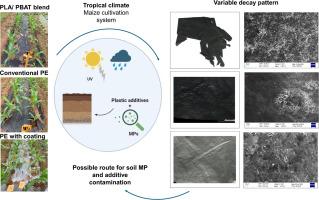三种对比地膜在热带条件下玉米栽培的原位降解
Q2 Environmental Science
引用次数: 0
摘要
塑料的广泛使用和释放,包括传统的和可生物降解的地膜,由于其对土壤质量和生态系统功能的影响,已成为一个主要的环境问题。在此,我们研究了三种塑料地膜(i)低密度聚乙烯(LDPE)地膜(PEM), (ii)反射性LDPE地膜(RPEM)和(iii)可生物降解PLA-PBAT地膜(BDM)在斯里兰卡两个玉米生长季节的降解模式。每月对地膜进行采样,使用FTIR-ATR、TGA、GC和GC- ms评估地膜质量、化学成分和物理完整性的变化。FTIR光谱证实了BDM各膜组分的递进变化,呈现出明显的峰组分变化。物理击穿的目视观察表明>;BDM提供的土壤表面覆盖度损失了30%,而LDPE薄膜显示出最小的表面破损迹象。BDM薄膜在第一个生长期损失了50%的质量,而RPEM和PEM薄膜分别仅损失了1%和6%的质量。总之,该研究提供了BDM地膜与LDPE地膜相比快速降解和成分变化的证据,可能是由于盛行的热带气候。未来的研究应侧重于提高bdm的物理完整性,并分析塑料添加剂和渗滤液对土壤和微生物的影响。本文章由计算机程序翻译,如有差异,请以英文原文为准。

In situ degradation of three contrasting plastic mulch films under maize cultivation in tropical conditions
The widespread use and release of plastics, including conventional and biodegradable mulch films, has become a major environmental concern due to their impact on soil quality and ecosystem functioning. Herein, we examined degradation patterns of three plastic mulch films (i) low-density polyethylene (LDPE) mulch (PEM), (ii) reflective LDPE mulch (RPEM), and (iii) biodegradable PLA-PBAT mulch (BDM), over two maize growing seasons in Sri Lanka. Mulch films were sampled monthly, with changes in mass, chemical composition, and physical integrity assessed using FTIR-ATR, TGA, GC, and GC-MS. FTIR spectra confirmed progressive compositional changes in all films with BDM showing significant peak compositional changes. Visual observations of physical breakdown showed that > 30% of soil surface coverage provided by BDM was lost while LDPE films showed minimal signs of surface breakage. BDM lost 50% of its mass over first growing season while RPEM and PEM films demonstrated only 1% and 6% mass loss, respectively. In conclusion, the study provides evidence of the rapid degradation and compositional changes of BDM mulches compared to LDPE mulches, likely due to prevailing tropical climate. Future research should focus on improving physical integrity of BDMs and analysing the effects of plastic additives and leachates on soil and microbes.
求助全文
通过发布文献求助,成功后即可免费获取论文全文。
去求助
来源期刊

Environmental Advances
Environmental Science-Environmental Science (miscellaneous)
CiteScore
7.30
自引率
0.00%
发文量
165
审稿时长
12 weeks
期刊介绍:
 求助内容:
求助内容: 应助结果提醒方式:
应助结果提醒方式:


